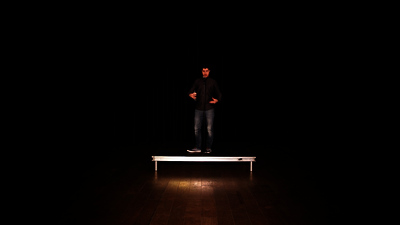Campbell, David, Durden, Mark and Brown, Ian (2016) I Can’t Go On, I’ll Go On, 'I Can’t Go On, I’ll Go On. [Show/Exhibition]
![[img]](/28012/1.hassmallThumbnailVersion/Common_Culture_Stills_Dave_07.jpg)
|
Image (Installation shot of “I Can’t Go On, I’ll Go On, 'I Can’t Go On, I’ll Go On- Dave”)
Common_Culture_Stills_Dave_07.jpg Download (398kB) | Preview |
Abstract
Brief Description:
Common Culture’s videos, I Can’t Go on, I’ll Go On, I Can’t Go On, I’ll Go On, (2016), strip down the conventions of televised stand-up comedy routines. The video works record two stand-up comedians performing for 40 mins, isolated and spot-lit on a small stage in an empty performance space, without an audience. Commissioned by Harris Museum and Art Gallery, Preston, where Davewas exhibited in Nothing Happens Twice: Artists Explore the Absurdity of Life the second part, Karen,was subsequently exhibited in Double Act: Art and Comedy at The Bluecoat, Liverpool.
Research Statement:
I Can’t Go on, I’ll Go On, I Can’t Go On, I’ll Go On (2016), explores the social and commercial aspects of the role of the stand-up comedian within popular televised entertainment. By deconstructing the components of the comic’s act, its structure as televised performance (editing, camera angles etc) and the familiar mechanics of the stand-up routine (the address of their own and the audience’s social identity) can be interrogated.
The televisual languages of the filmed performance are established and destabilised in an enquiry into the processes by which individuals attain commodity form. The intention of I Can’t Go On, I’ll Go On… (Karen), is to articulate the alienation of the subject in the context of its consumption within television culturethrough mechanistic editing, indifferent to the actions of the performing subject.
In I Can’t Go On, I’ll Go On… (Dave)the editing is removed entirely; the viewer is presented with separate raw footage from which conventional televised stand-up routines are formed. The typical constituents of the act are presented but as discrete elements, wide-angle and close-up footage shown on seperate screens. The work invites the audience to take on an active role of editor in determining which screen to view, deciding between the empathetic close-up or the alienating long-shot, prompting reflection on the highly mediated nature of the televisual act.
The consequences of the change of conditions, by which the act itself is exposed, differ between the two works. In Karenthe self-reflection created, results in a segment where the performer is overwhelmed, forcing a break in the routine. The confident role of performer as commodity is momentarily exchanged for the uncontrolled behaviour of the individual. This transgression creates a gap or subversion in the form and this displacement undermines, and reveals, the structure of the ‘product’ of entertainment.
| Item Type: | Show/Exhibition |
|---|---|
| Subjects: | W100 Fine Art |
| Department: | Faculties > Arts, Design and Social Sciences > Arts |
| Depositing User: | David Campbell |
| Date Deposited: | 18 Oct 2016 09:02 |
| Last Modified: | 04 Jul 2019 13:38 |
| URI: | http://nrl.northumbria.ac.uk/id/eprint/28012 |
Downloads
Downloads per month over past year







